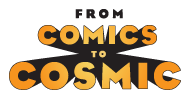“From Comics to Cosmic” is a new series from noted comic book writer/artist Steve Englehart. Read about the intense and often unbelievable ups and downs of his experience working in the comic industry. Check back daily for more of his exploits!
° ° °
I have no idea if this is common among writers, but in my case, there are extant examples of my creating books as a child by figuring out how the pages would fold together and then typing (on a typewriter) as necessary to make it come out right. In other words, I wasn’t satisfied just writing a story; I wanted a book. After that, you’d think I’d grow up to be a publisher, but I settled (if that’s the word) for being a writer.
On second thought, maybe that is the word, because I wanted to be an artist.
Now, all of this was taking place in terms of pop culture—I make no pretensions otherwise—so the art I’m talking about was comic book art. When I made those books, I added illustrations. Basically, books were a delivery system for pictures. All the way up through college, I concentrated on line drawing, based on comics. I loved (and still love) the black-and-white nature of that art, the juicy black lines or delicate feathering used to convey texture and mood with no color whatsoever (so color then became a bonus). I loved Chester Gould’s Dick Tracy, and I loved Paul Murry’s Mickey Mouse Mysteries, and I loved Dick Sprang’s Batman--all the dark and dramatic strips. (Don’t think Mickey could be dark and dramatic? You’re wrong.)
And in the fullness of time, I got to draw for comics. There are extant examples of my art out there. But a funny thing happened on my way to the inkpot.
In those days, the first requisite for working in comics was moving to New York. There were a lot of books (I suppose I should say “mags,” but that’s what we call them in that biz) and all of them were on regular deadlines, either monthly or bi-monthly. Which meant a lot of people had to do their jobs on a daily basis. So as a wannabe, you moved to New York, went to the offices of the several publishers (Marvel and DC were the biggies, but there were others) and showed your samples. Then, assuming you showed at least some promise, you went back to your friend’s couch where you were crashing and waited for a call. Because within a month or two, somebody in that continual production milieu would get sick or somehow miss a deadline and you’d get your shot. If you could handle it, you were in.
I had my shot and got in, as a lower-level artist at DC and lesser houses. But one summer night, a stewardess living in the apartment above that of a Marvel assistant editor was murdered, and the assistant editor’s wife insisted that they get out of the city for a while. He called me and asked if I’d fill in for him for six weeks. I had moved out to Milford, Connecticut, by then—two hours into Grand Central by train, and two hours out, every day. I almost said no. But I said yes…
Steve Englehart is a novelist, comic book, film, television, and video game writer known for his work on high profile titles, including Marvel’s Captain America, The Hulk, The Avengers, Dr. Strange, DC’s Superman, Batman, Wonder Woman, Flash, Green Lantern, and many more.










